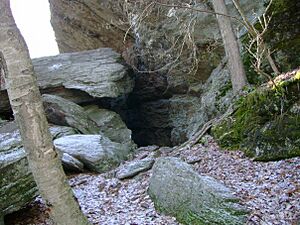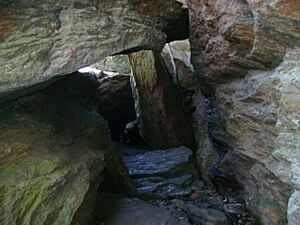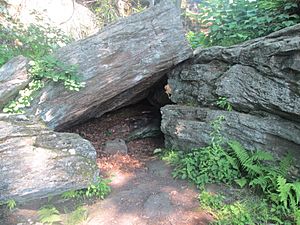Leatherman (vagabond) facts for kids
The Leatherman was a mysterious traveler famous for his unique leather clothes. He walked a regular path through the northeastern United States from about 1857 to 1889. His journey took him between the Connecticut River and the Hudson River. No one knew where he came from, but many thought he was French Canadian because he spoke French fluently and his English was "broken." A French prayer book was found with him after he died. His true identity is still a mystery. He walked a repeating 365-mile route, visiting certain towns in western Connecticut and eastern New York every 34–36 days.
Contents
Life of the Leatherman

The Leatherman lived in natural rock shelters and caves, which are now sometimes called "Leatherman caves." He would stop in towns along his 365-mile route about every five weeks. There, he would get food and other supplies. He was called the "Leatherman" because his hat, scarf, clothes, and even his shoes were all handmade from leather.
An old newspaper article from 1870 called him the "Leather-Clad Man." It said he rarely spoke, and when he did, he used only one-syllable words. Some rumors at the time suggested he was from Picardy, France.
He was very good at speaking French. However, he mostly communicated with grunts and hand gestures, using his broken English only sometimes. If anyone asked about his past, he would quickly end the conversation. When he died, a French prayer book was found among his few belongings. He also refused to eat meat on Fridays, which made people think he might have been Roman Catholic.
No one knows how he earned money. One store recorded an order he made: "one loaf of bread, a can of sardines, one-pound of fancy crackers, a pie, and two quarts of coffee."
The Leatherman was very well known in Connecticut. People could count on him to arrive on his regular schedule. Many would have food ready for him, which he often ate on their doorsteps. Ten towns along his route even passed special rules. These rules made sure he was not affected by a state "tramp law" that was passed in 1879.
Leatherman's Health
The Leatherman survived cold blizzards and bad weather by making fires in his rock shelters. Even though his face was sometimes frostbitten in winter, he never lost any fingers. This was different from other homeless people in the area at that time.
In 1888, the Connecticut Humane Society had him taken to a hospital. Doctors said he was "sane except for an emotional problem." He was then released because he had some money and wanted to be free. He eventually died from cancer of the mouth. His body was found on March 24, 1889. He was in his Saw Mill Woods cave on a farm in Mount Pleasant, New York, near Ossining.
Leatherman's Grave

The Leatherman's grave is in the Sparta Cemetery in Ossining (town), New York. His first tombstone had this message carved on it:
FINAL RESTING PLACE OF
Jules Bourglay
OF LYONS, FRANCE
"THE LEATHER MAN"
who regularly walked a 365-mile route
through Westchester and Connecticut from
the Connecticut River to the Hudson
living in caves in the years
1858–1889
Later, the Leatherman's grave was moved further away from Route 9. When the first grave was dug up, no remains of his body were found. Only some coffin nails were discovered. These nails, along with dirt from the old grave, were reburied in a new wooden box. Nicholas Bellantoni, an archaeologist, explained why the body was gone. He said it was due to time, traffic over the shallow grave, and possibly road work. The new tombstone was put in place on May 25, 2011. It simply reads "The Leatherman." The exhumation was also done to try and learn more about his origins, but no remains were found for testing.
Towns the Leatherman Visited
The Leatherman's regular route included these towns:
- Brewster, New York
- North Salem, New York
- Ridgefield, Connecticut
- Branchville, Connecticut
- Georgetown, Connecticut
- Redding, Connecticut
- Danbury, Connecticut
- Woodbury, Connecticut
- Watertown, Connecticut
- Thomaston, Connecticut
- Terryville, Connecticut
- Bridgewater, Connecticut
- Waterbury, Connecticut
- Bristol, Connecticut
- Forestville, Connecticut
- New Britain, Connecticut
- Berlin, Connecticut
- Old Saybrook, Connecticut
- Guilford, Connecticut
- Branford, Connecticut
- East Haven, Connecticut
- New Haven, Connecticut
- Bronxville, New York
- Stratford, Connecticut
- Bridgeport, Connecticut
- Trumbull, Connecticut
- Norwalk, Connecticut
- New Canaan, Connecticut
- Stamford, Connecticut
- Greenwich, Connecticut
- White Plains, New York
- Armonk, New York
- Chappaqua, New York
- Ossining, New York
- Sleepy Hollow, New York
- Mount Kisco, New York
- Bedford Hills, New York
- Pound Ridge, New York
- Yorktown, New York
- Peekskill, New York
- Somers, New York
- Derby, Connecticut
- Woodbridge, Connecticut
- Naugatuck, Connecticut
- Hamden, Connecticut
- Southington, Connecticut
- Burlington, Connecticut
- Middletown, Connecticut
- Meriden, Connecticut
- Portland, Connecticut
- Wilton, Connecticut
The Leatherman in Popular Culture
- The American rock band Pearl Jam wrote a song called "Leatherman." It was released as a B-side to their song "Given to Fly" from their 1998 album Yield.
- The Finnish singer-songwriter J. Karjalainen mentions the "New England Leatherman" in his song "Mennyt mies".
- A video documentary about the Leatherman was made in 1984. It was shown on Connecticut Public Television.
- In 1965, Mark Haber was interviewed about the Leatherman on a TV program called Perception on Channel 3 in Hartford, Connecticut.
See also
 In Spanish: Leatherman (vagabundo) para niños
In Spanish: Leatherman (vagabundo) para niños



